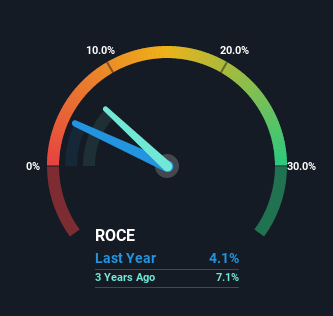
What underlying fundamental trends can indicate that a company might be in decline? A business that's potentially in decline often shows two trends, a return on capital employed (ROCE) that's declining, and a base of capital employed that's also declining. Basically the company is earning less on its investments and it is also reducing its total assets. Having said that, after a brief look, Paz Oil (TLV:PZOL) we aren't filled with optimism, but let's investigate further.
Return On Capital Employed (ROCE): What is it?
For those that aren't sure what ROCE is, it measures the amount of pre-tax profits a company can generate from the capital employed in its business. Analysts use this formula to calculate it for Paz Oil:
Return on Capital Employed = Earnings Before Interest and Tax (EBIT) ÷ (Total Assets - Current Liabilities)
0.041 = ₪435m ÷ (₪15b - ₪4.7b) (Based on the trailing twelve months to March 2022).
Therefore, Paz Oil has an ROCE of 4.1%. Ultimately, that's a low return and it under-performs the Oil and Gas industry average of 9.2%.
See our latest analysis for Paz Oil

Historical performance is a great place to start when researching a stock so above you can see the gauge for Paz Oil's ROCE against it's prior returns. If you're interested in investigating Paz Oil's past further, check out this free graph of past earnings, revenue and cash flow.
The Trend Of ROCE
There is reason to be cautious about Paz Oil, given the returns are trending downwards. Unfortunately the returns on capital have diminished from the 7.7% that they were earning five years ago. Meanwhile, capital employed in the business has stayed roughly the flat over the period. Since returns are falling and the business has the same amount of assets employed, this can suggest it's a mature business that hasn't had much growth in the last five years. If these trends continue, we wouldn't expect Paz Oil to turn into a multi-bagger.
On a side note, Paz Oil's current liabilities have increased over the last five years to 31% of total assets, effectively distorting the ROCE to some degree. If current liabilities hadn't increased as much as they did, the ROCE could actually be even lower. While the ratio isn't currently too high, it's worth keeping an eye on this because if it gets particularly high, the business could then face some new elements of risk.
In Conclusion...
In summary, it's unfortunate that Paz Oil is generating lower returns from the same amount of capital. It should come as no surprise then that the stock has fallen 18% over the last five years, so it looks like investors are recognizing these changes. That being the case, unless the underlying trends revert to a more positive trajectory, we'd consider looking elsewhere.
Paz Oil does come with some risks though, we found 3 warning signs in our investment analysis, and 2 of those don't sit too well with us...
If you want to search for solid companies with great earnings, check out this free list of companies with good balance sheets and impressive returns on equity.
If you're looking to trade Paz Retail And Energy, open an account with the lowest-cost platform trusted by professionals, Interactive Brokers.
With clients in over 200 countries and territories, and access to 160 markets, IBKR lets you trade stocks, options, futures, forex, bonds and funds from a single integrated account.
Enjoy no hidden fees, no account minimums, and FX conversion rates as low as 0.03%, far better than what most brokers offer.
Sponsored ContentNew: Manage All Your Stock Portfolios in One Place
We've created the ultimate portfolio companion for stock investors, and it's free.
• Connect an unlimited number of Portfolios and see your total in one currency
• Be alerted to new Warning Signs or Risks via email or mobile
• Track the Fair Value of your stocks
Have feedback on this article? Concerned about the content? Get in touch with us directly. Alternatively, email editorial-team (at) simplywallst.com.
This article by Simply Wall St is general in nature. We provide commentary based on historical data and analyst forecasts only using an unbiased methodology and our articles are not intended to be financial advice. It does not constitute a recommendation to buy or sell any stock, and does not take account of your objectives, or your financial situation. We aim to bring you long-term focused analysis driven by fundamental data. Note that our analysis may not factor in the latest price-sensitive company announcements or qualitative material. Simply Wall St has no position in any stocks mentioned.
About TASE:PAZ
Paz Retail And Energy
Paz Retail And Energy Ltd., together with its subsidiaries, refines, produces, stores, imports, markets, and sells petroleum and other products in Israel and internationally.
Established dividend payer and good value.
Similar Companies
Market Insights
Community Narratives




